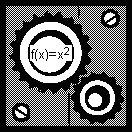| << Chapter < Page | Chapter >> Page > |
In examples above, we saw that if , then . We also saw that the function , which may have looked just as likely, did not work as an inverse function. So in general, given a function, how do you find its inverse function?
Remember that an inverse function reverses the inputs and outputs. When we graph functions, we always represent the incoming number as and the outgoing number as . So to find the inverse function, switch the x and y values, and then solve for .
Were you surprised by the answer? At first glance, it seems that the numbers in the original function (the 2, 3, and 5) have been rearranged almost at random.
But with more thought, the solution becomes very intuitive. The original function described the following process: double a number, then subtract 3, then divide by 5 . To reverse this process, we need to reverse each step in order: multiply by 5, then add 3, then divide by 2 . This is just what the inverse function does.
Some functions have no inverse function. The reason is the rule of consistency.
For instance, consider the function . This function takes both 3 and –3 and turns them into 9. No problem: a function is allowed to turn different inputs into the same output . However, what does that say about the inverse of this particular function? In order to fulfill the requirement of an inverse function, it would have to take 9, and turn it into both 3 and –3—which is the one and only thing that functions are not allowed to do. Hence, the inverse of this function would not be a function at all!
 |
 |
In general, any function that turns multiple inputs into the same output, does not have an inverse function.
What does that mean in the real world? If we can convert Fahrenheit to Celsius, we must be able to convert Celsius to Fahrenheit. If we can ask “How much money did Alice make in 3 days?” we must surely be able to ask “How long did it take Alice to make $500?” When would you have a function that cannot be inverted?
Let’s go back to this example:
Recall the example that was used earlier: “Max threw a ball. The height of the ball depends on how many seconds it has been in the air.” The two variables here are (the height of the ball) and (the number of seconds it has been in the air). The function enables us to answer questions such as “After 3 seconds, where is the ball?”
The inverse question would be “At what time was the ball 10 feet in the air?” The problem with that question is, it may well have two answers !
| The ball is here... | ...after this much time has elapsed |
|---|---|
| 10 ft | 2 seconds (*on the way up) |
| 10 ft | 5 seconds (*on the way back down) |
So what does that mean? Does it mean we can’t ask that question? Of course not. We can ask that question, and we can expect to mathematically find the answer, or answers—and we will do so in the quadratic chapter. However, it does mean that time is not a function of height because such a “function” would not be consistent: one question would produce multiple answers.

Notification Switch
Would you like to follow the 'Functions' conversation and receive update notifications?